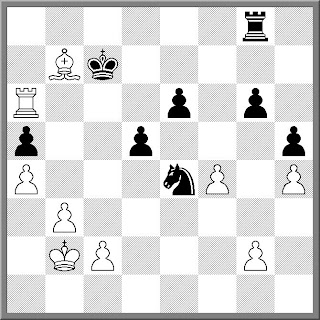
Here is a nice game won by the future grandmaster Peter Leko when he was only 12 years old. Keep an eye on White's light-squared bishop!
Leko,P (2460) - Ruzele,D (2340)
Debrecen 1992
French Defence C11
1.e4 e6 2.d4 d5 3.Nc3 Nf6 4.e5 Nfd7 5.f4 c5 6.Nf3 Nc6 7.Be3 cxd4 8.Nxd4 Bc5 9.Qd2 Bxd4 10.Bxd4 Nxd4 11.Qxd4 Qb6
This plan involving massive exchanges on d4 was introduced by Gideon Stahlberg in 1960. Over the years it has attracted sporadic attention, notably from Mikhail Gurevich and Viktor Korchnoi. At the grandmaster level it is a fairly safe way to play for a draw with the Black pieces, but anyone at a lower level is not going to have an enjoyable time. By the way, Stahlberg lost that first game -- to Mikhail Tal.
12.0–0–0 Qxd4 13.Rxd4 Ke7 14.h4!
A nice, thematic move. If unopposed, White will set up his pawns on e5, f4 g4, and h5, and threaten a breakthrough at an appropriate moment. Black's next move opposes this plan but it has the disadvantage of fixing his kingside pawns on light squares.
14...h5
Leko mentioned 14...f6 in Informant 56, but this lets White get a clear advantage after 15.exf6+ gxf6 16.f5! Nb6 17.fxe6 Bxe6 18.Bd3.
15.Be2 Nb8 16.Rd2 Bd7 17.Rhd1 g6
This must be played sooner or later; otherwise Black will be unable to move his rook from h8.
18.b3! Bc6!?
And not 18...Nc6 on account of 19.Ne4! with advantage to White, for example, 19...Rhd8 20.Nd6 b6 21.c4! and Black is in difficulties.
19.Bf3 Nd7 20.Ne2 Rhc8
Pressure along the c-file is Black's only active plan. Almost everything else will create weaknesses. But with White's king on hand to defend the queenside it is unlikely that Black will achieve anything concrete.
21.Nd4 Rc7 22.Kb2 Nb6 23.Rd3!
Not 23.a4? Bxa4! 24.bxa4 Nc4+ followed by 24...Nxd2 with decent play for Black.
23...Bd7 24.a4! a5 25.Be2
White has taken control of the key square b5 and now has possibilities on both wings.
25...Rac8 26.Rh3 Bc6 27.Rg1 Rh8
It was probably better to recycle the knight with 27...Nd7.
28.Rc3!
Threatening to attack the pawn on a5.
28...Nd7 29.Rh1 Rcc8 30.Rhh3 Rhg8
By alternating play on both wings, White has brought all his pieces to active positions while Black has been forced into passivity. It is now time to strike.
A nice combination of tactics and strategy, opening up the position and exposing Black to further attack. "A weakness of the dark squares is also a weakness of the light squares," wrote David Bronstein.
31...f6
Black is losing a pawn, so he tries to gain some activity. If 31...Nb8 then 32.Nxc6+ Rxc6 33.Bxb7 Rxc3 34.Rxc3 Kd7 35.Ka3 with the idea of 36.b4 with a winning position for White.
32.exf6+ Nxf6 33.Nxc6+
Now that e6 has been weakened, it was also possible to play 33.Rce3 Ne4 34.Bd3 Nc5 35.Rhg3 with continuing pressure for White.
33...Rxc6 34.Bxb7 Rb6 35.Rc7+ Kd6 36.Rhc3 Ne4
In Informant Leko gave the line 36...Rb8 37.Rf7 Ne4 38.Rcc7 as winning for White, but there is a huge flaw in this: 38...Nc5! 39.Bc8 Nxa4+ 40.Kc1 Nc5 and Black is suddenly much better.
After 36...Rb8 the right idea is 37.Bc8! d4 38.R3c4 Kd5 39.Re7, when Black is more or less in zugzwang; for example, 39...Ke4 (or 39...Ne4 40.Kc1 Nc5 41.Rc7 Ne4 42.Bd7) 40.Rxe6+ Rxe6 41.Bxe6 Kxf4 42.Bf7 Rd8 43.Bxg6 Kg3 44.Rc5 Kxh4 45.Rf5 Nd5 46.Bxh5 Ne3 47.Rxa5 Nxg2 48.Be2 and White must be winning.
37.R3c6+ Rxc6 38.Rxc6+ Kd7 39.Ra6! Kc7
Leko gave 39...Nc5 40.Rb6! and wins. One should also mention 39...Rf8, on which there could follow 40.Bc6+ Kc7 41.Bb5 Rxf4 42.Rxe6 Rg4 43.Be8 Rxg2 44.Rc6+ Kb8 45.Rxg6 Rh2 46.Ra6 Rxh4 47.Rxa5 Nf6 48.Bf7 d4 49.b4 Rh3 50.Rf5 and wins.

40.Ba8! Rf8 41.c4! Rxf4 42.cxd5 e5 43.Rxa5
Another way forward was 43.Rxg6 Rxh4 44.Re6 Nf2 45.Kc2, etc.
43...Rxh4
If 43...Rf2+ 44.Ka3 Rxg2 then 45.d6+.
44.d6+! Nxd6
Or 44...Kxd6 45.Ra6+ Kc7 46.Rxg6 Nd6 47.Rg5.
45.Rxe5 Kb8
If 45...Rxa4 then 46.Rc5+, etc.
46.Bd5 Rg4 47.a5 Rd4 48.Bf3 Nf5 49.Kc3 Rf4 50.Re4 Rh4 51.Rxh4 Nxh4 52.Be4 1–0
In many ways a typical game from the modern era. Strategically, White's play was not too complicated, but the key to success was the exploitation of Black's weaknesses with exactly calculated tactical play. White got his attack in first and Black's counterplay was just too slow. Bobby Fischer won a lot of games this way!


No comments:
Post a Comment